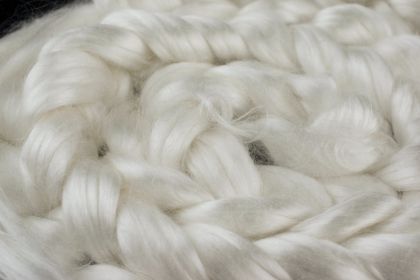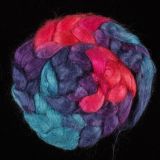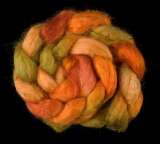Bombyx Silk Combed Top/Sliver (A1 Quality, China) - 50g
A1 grade Bombyx Silk Combed Top/Sliver. Bombyx silk is also known as cultivated silk or mulberry silk. Fiber length is 8-9 inches and it's about 15 microns in diameter.
There are over 500 different species of silk-producing caterpillars, but only a few produce a viable silk that can be harvested. People are most familiar with the silk from Bombyx mori silk worms. This is the silk worm that has been domesticated and cultivated for over 5,000 years.
This silk worm eats only mulberry leaves. We call this “Bombyx” silk, but it is often called “mulberry” or “cultivated” silk.
The cocoons from the Bombyx mori silk worm can have up to a mile of continuous silk filament. It sounds like a lot, but you need 1,000 cocoons to make a single silk shirt.
Bombyx silk naturally a silvery white. The fiber is rather slippery to spin, so you will likely find this to be the biggest challenge of the wide vareity of 100% silks that Treenway Silks offers.
Silk handspun and handknitted by Diane de Souza
50 Gram (1.8 oz) packages
Silk from China
Color: natural silvery-white
All Bombyx (mulberry) Silk is NOT the Same
Most silk is from the cultivated, Bombyx mori silk worm (also known as mulberry silk). There are different ‘strains’ of Bombxy mori silk worms.
To simplify, compare “Bombyx Silk” to “apples”. Just as apples can be classified as “eating” or “baking” apples, the Bombyx mori silk worm can be classified as “bi-voltine” or “multi-voltine”.
Bivoltine Strain—bombyx mori (two generations--or crops--per year)
1) The bivoltine silk worms spin larger cocoons which produce up to a mile of silk. This thread is good quality (even, lustrous and strong).
2) These strains of silk worms are highly vulnerable to disease and require strict hygiene and meticulous conditions to produce cocoons.
3) All these factors combine to make silk from bivoltine strains command a higher price.
Most Bombyx mori silk from China is a bivoltine strain. Treenway Silks carries only China bombyx silks from bivoltine silk worms.
Multivoltine Strain—bombyx mori (more than two generations per year)
1) The multivoltine silk worms are more resistant to disease and can produce cocoons in less rigorous rearing conditions.
2) However, compared to bivoltine strains, the multivoltine silk thread is lesser quality and the cocoons are much smaller (25%-50% in size).
3) The silk from multivoltine strains is more economical, reflecting the difference in quality.
Most Bombyx mori silk raised in India is a multivoltine strain.
roving
roving







